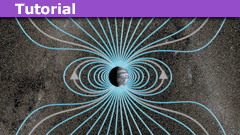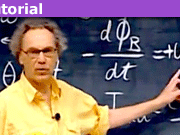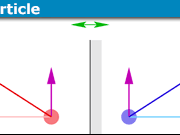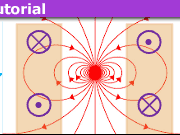Maxwell’s Equations in Magnetostatics and Solving with the Curl Operator
Table of Contents
Introduction:
Maxwell’s equation in differential form ## \nabla \times \vec{B}=\mu_o \vec{J}_{total}+\mu_o \epsilon_o \dot{\vec{E}} ## with ## \dot{\vec{E}}=0 ## comes up quite frequently in magnetostatic problems. In addition, the equation from the magnetic pole model ## \vec{B}=\mu_o \vec{H}+ \mu_o \vec{M} ## comes up quite often as well. It seems the textbooks are somewhat lacking in a thorough treatment of the use of these two equations, and the mathematical operations that can be used to generate solutions. In this Insights article, we will attempt to fill that gap.
In this paper, we will consider two rather different problems, which both employ the vector ## \vec{H} ##. The first involves an integral expression for ## \vec{H} ##. The second involves a derivation of the magnetomotive force (MMF) equation. The EE’s often use this equation in working with transformers. Here we will show that this MMF equation arises from an alternate form of Maxwell’s/Ampere’s Law equation.
For one final task, after we have worked through these two problems with ## \vec{H} ##, we will consider one additional application of the curl equation, where we will attempt to recover ## \vec{M} ## from the equation ## \nabla \times \vec{M}=\vec{J}_m ##, where the system under consideration is a cylinder of finite length with uniform magnetization ## \vec{M} ##.
An Alternate form of Maxwell’s/Ampere’s Law Equation:
Let’s take the curl of both sides of our magnetic pole model equation above and “link” it to Maxwell’s equation above:
## \nabla \times \vec{B}=\mu_o \nabla \times \vec{H} +\mu_o \nabla \times \vec{M}=\mu_o (\vec{J}_{conductors}+\vec{J}_m+\vec{J}_p )+\mu_o \epsilon_o \dot{\vec{E}} ##
where ## \vec{J}_m=\nabla \times \vec{M} ##, and ## \vec{J}_p=\dot{\vec{P}} ##.
The result, after a little algebra is ## \nabla \times \vec{H}=\vec{J}_{conductors}+\dot{\vec{D}} ##,
where ## \vec{D}=\epsilon_o \vec{E}+\vec{P} ##.
The equation ## \nabla \times \vec{H}=\vec{J}_{conductors}+\dot{\vec{D}} ## is an alternative form of Maxwell’s/ Ampere’s
Law, and it comes in very handy for a couple of different problems with magnetic systems.
For both of these, we will assume that steady state conditions apply, so that we can assume ## \dot{\vec{D}}=0 ##.
An Integral Solution for ## H ## using a Biot-Savart type solution plus necessary additions:
For the first case, we will then use the known Biot-Savart type solution for the curl equation:
## \vec{H}(\vec{r})=\int \frac{\vec{J}_{conductors}(\vec{r}’) \times (\vec{r}-\vec{r}’)}{4 \pi |\vec{r}-\vec{r}’|^3} \, d^3 \vec{r}’ ##.
This solution looks simple enough, but anyone familiar with the pole model of magnetostatics will ask, “what happened to the contribution to ## \vec{H} ## that comes from the magnetic poles? “. Our solution is, in fact, incomplete, and to make it complete, we need to include a solution to the homegeneous differential equation ## \nabla \times \vec{H}=0 ##, in order to make it complete. It is perhaps for this reason that the E&M textbooks commonly don’t show the Biot-Savart/integral form of the curl equation, but often prefer to employ Stokes’ theorem, when an equation involving the curl operator is encountered.
A similar type calculation for H using the divergence operator:
It should be noted that if we had chosen instead to taken the divergence of both sides of the ## \vec{B}=\mu_o\vec{H}+\mu_o \vec{M} ## equation, and employed ## \nabla \cdot \vec{B}=0 ##, to get
##\nabla \cdot \vec{H}=-\nabla \cdot \vec{M} ##,
there then is a well-known integral solution for ## \vec{H}(\vec{r})= –\int \frac{\nabla’ \cdot \vec{M}(\vec{r}’) (\vec{r}-\vec{r}’)}{4 \pi |\vec{r}-\vec{r}’|^3} \, d^3 \vec{r}’ ## that would give us the contributions from the magnetic poles, but it ignores the contributions to ## \vec{H} ## from the conductors. In this case, a solution to the homogeneous equation ## \nabla \cdot \vec{H}=0 ## needs to be included for the solution for ## \vec{H} ## to be complete. Meanwhile, this ## \vec{H} ## from the divergence equation is precisely the contribution from the poles that we needed above, that is the solution to the above homogeneous equation ## \nabla \times \vec{H}=0 ##. Likewise, the solution for ## \vec{H} ## that we found for the curl equation above is, in fact, the solution that we need to the homogeneous equation ## \nabla \cdot H=0 ##.
Surprisingly, the complete solution for ## H ## is generated by computing the integral solution from the curl equation with ## \vec{H} ##, and also computing the integral solution from the divergence equation with ## \vec{H} ##, and adding both solutions.
A Derivation of the magnetomotive force (MMF) equation from the alternate form of Ampere’s law that uses H:
For our next task, we will begin again with ## \nabla \times \vec{H}=\vec{J}_{conductors} ## and we will derive the magnetomotive force (MMF ) equation.
Integrating over an area, and applying Stokes’ theorem, and taking the case of a transformer with ## N ## turns, (with the path of integration going through and around the entire interior of the transformer, we get
## \oint \vec{H} \cdot d \vec{l}=NI ##.
Now, let us assume a linear material, so that ## \vec{B}=\mu \vec{H} ##, and also that the magnetic flux ##\Phi=BA ## is constant everywhere in the loop. Then we can write:
##\Phi \oint \frac{d l}{\mu A} =NI ##, which is the MMF equation that the EE’s use in transformer calculations.
See this discussion on Physics Forums for additional info on a common case of a transformer with an air gap, for which the MMF equation is applied.
One additional application using the Biot-Savart type solution to try to recover the magnetization vector M for a finite cylinder:
Consider now a cylinder of finite length with uniform magnetization ## \vec{M} ## along its axis. We can write ## \nabla \times \vec{M}=\vec{J}_m ##, and the result is there is a magnetic surface current per unit length ##\vec{K}_m=\vec{M} \times \hat{n} ## on the outer surface of the magnetized cylinder.
Maxwell’s equation for this case says ## \nabla \times \vec{B}=\mu_o \vec{J}_m ##, but here we have a second equation ## \nabla \times \vec{M}=\vec{J}_m ##.
If we take the equation for ## \vec{B} ##, we can write out the Biot-Savart solution, and the magnetic field ## \vec{B} ## has the same geometry as the magnetic field of a solenoid. Thereby, if we write out the Biot-Savart type integral solution for ## \vec{M} ##, we clearly do not obtain the original uniform finite cylinder form for ## \vec{M} ##. To get it to this final form, we need to include a solution of homogeneous equation ## \nabla \times \vec{M}=0 ##. That homogeneous solution is the one which results if one places plus and minus magnetic poles at the end faces of the cylinder, and computes ## \vec{H} ## from them. That homogeneous solution, (with the appropriate multiplicative constant), is subtracted from the Biot-Savart type solution for ## \vec{M} ## to recover the correct ## \vec{M} ## that we started with. The details of this calculation are left to the reader, but for those readers familiar with both the magnetic pole model calculations and the magnetic surface current calculations for this problem, they should be able to recognize that this is the case. See this thread for additional introductory material.
B.S. Physics with High Departmental Distinction= University of Illinois at Urbana-Champaign 1977. M.S. Physics UCLA 1979. Worked for 25+ years as a physicist doing electro-optic research at Northrop-Grumman in Rolling Meadows, Illinois.










Leave a Reply
Want to join the discussion?Feel free to contribute!